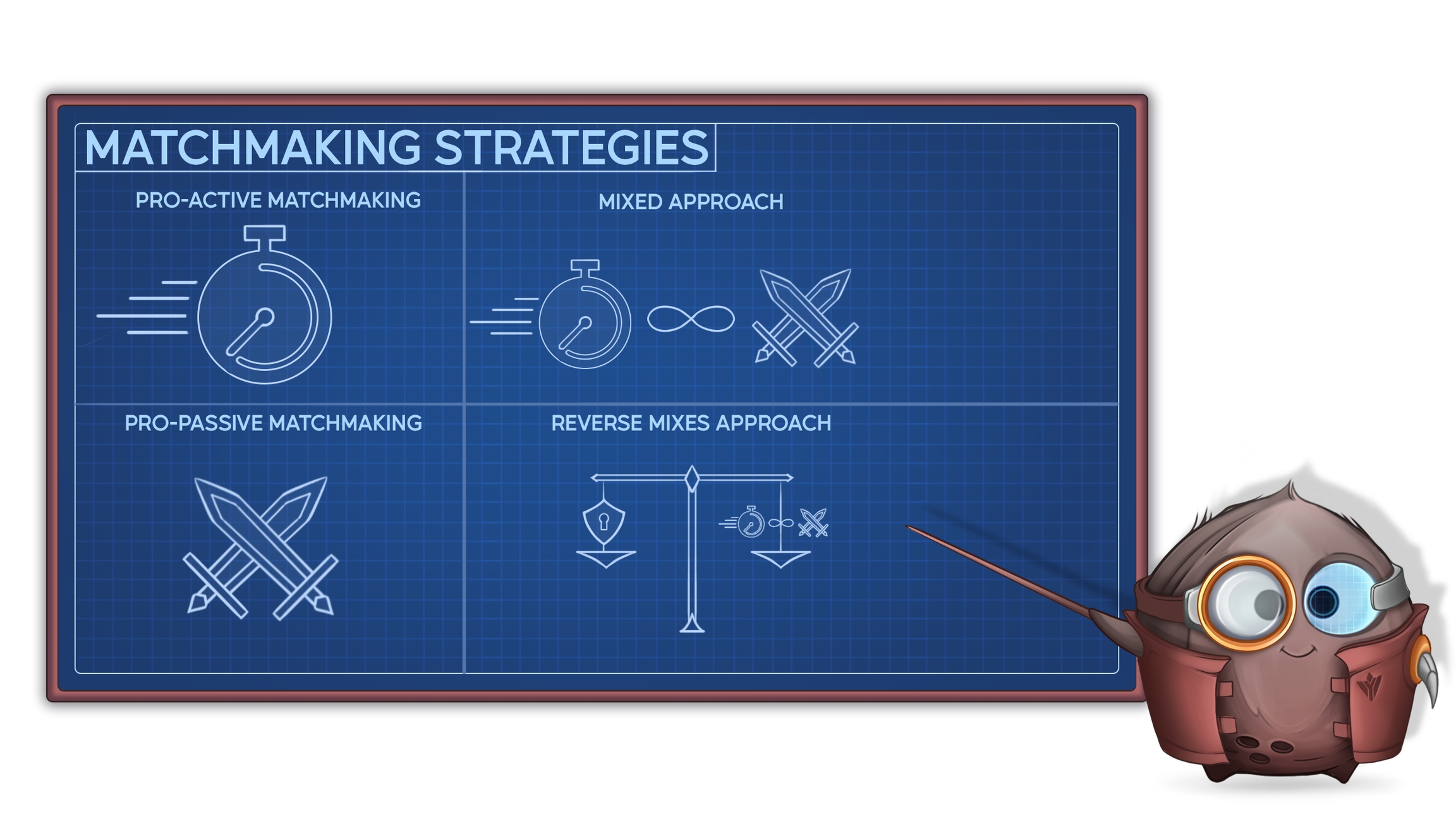👨❤️👨Blockchain Matchmaking

The entirely blockchain-based matchmaking in our project serves as the foundation for a fair gameplay. In this section, we'll discuss the significance of fair and transparent matchmaking, focusing on financial fairness and player retention. Additionally, we'll touch on the unique challenges of implementing a matchmaking system in a blockchain-based gaming environment.
Importance of Fair Matchmaking
A well-balanced and fair matchmaking system is crucial for maintaining trust and engagement among players.
In games where outcomes bear strategic and financial weight, it's crucial for players to be confident they're on an even playing field with each other. A balanced matchmaking system guarantees players are consistently paired with opponents boasting comparable banana sets. This cultivates an atmosphere where success hinges on strategic decisions and a touch of luck, instead of system exploitation by malevolent entities.
Moreover, equitable matchmaking plays a critical role in player retention and the project's longevity. When players view the system as fair, they're more likely to stay committed, investing both time and resources. Conversely, perceived unfairness can lead to player disengagement, a possible decline in revenues, and tarnished trust in the platform.
A pervasive "casino always wins" mindset might make players feel their odds are skewed, placing them at a distinct disadvantage.
By implementing a fully blockchain-based matchmaking system with transparent contract logic, we alleviate these concerns, bolstering player trust in the process's fairness.
Challenges of Blockchain-based Matchmaking
Crafting a balanced matchmaking system within a blockchain realm poses its own set of problems.
One significant hurdle is blockchain's intrinsic transparency. While often touted as a boon, in matchmaking, it can open doors for exploitation. Savvy players might scrutinize different pools, selecting ones where they hold a distinct edge.
On the other hand, the dynamic and unpredictable nature of blockchain transactions implies that matchmaking requests from players could be handled at unknown varied intervals, adding an extra layer of randomness to the process and diluting the potential for exploitation.
In the following segments, we'll explore various approaches we considered to address these challenges, striving to create a balanced matchmaking system that caters to both active and passive players, while minimizing chances of external foul play.
Exploitation Risks and Transparency
In this section we'd like to remind readers about risks associated with blockchain matchmaking and the possible countermeasures in place.
Passive Players: Predictable and Vulnerable
In a blockchain-based matchmaking system, passive players' banana sets are fully transparent, allowing potential exploiters to get queued IDs, analyze and then cherry-pick pools specifically crafted to counter them.
Such tactics could sway duels in favor of players who deliberately target passive pools, armed with a banana set tailored to dominate the majority of the available opponents. This poses an inherent risk, undermining fair play and threatening the integrity of our tokenomics.
Balancing Risks with Opportunities
To mitigate these exploitation risks, we suggest refining the passive player pool's minimum size required for matching during our inaugural season, using data analytics.
By expanding pool limit, we can confound exploiters, ensuring a more balanced and equitable matchmaking experience.
Passive Player Pool Adjustments
Balancing Winning Odds
Our matchmaking objective is to preserve the victory odds for actively paired players vs passive players within a 49%-55% bracket. This slight tilt towards the active player is designed to incentivize engagement without compromising fairness.
As we collate data from beta trials, we'll adjust passive pool sizes accordingly, ensuring our system remains adaptable and responsive to real-time player experiences.
Matchmaking Approaches
In general, we divide matchmaking into two flows:
matchmaking for players actively searching for a match (active matchmaking)
players queuing for multiple duels at a time and passively awaiting results when they come back (passive matchmaking)
For simplicity, we term these as Active and Passive matchmaking modes. Any algorithm will have to lean either in favor of one or the other by prioritizing Passive or Active pools based on subsequent quantity of players between two pool types.
We strive to find a balance between both, covering as many weak points as we can.
Matchmaking Strategies
Pro-Active Matchmaking - emphasis on speed, prioritizes lower queue times for matches
Pro-Passive Matchmaking - emphasis on amount of matches for passively queued players
Mixed Approach - emphasis on balance between speed and match count
Reverse Mixes Approach - emphasis on exploitation risk protection over both matchmaking speed and match count

Pro-Active Matchmaking
Pro-active matchmaking prioritizes matching 2 active players currently searching for a match instead of looking for passive players. This approach has the advantage of providing quicker matches for active players. However, it can lead to a disadvantage for passive players as they may get much less matches as long as 2 or more people are actively playing the game.
In addition active players could potentially exploit the transparency of the blockchain to target specific opponents. In this setup, active players are matched only if there are at least two of them in the pool, reducing the chances of exploiting the matchmaking process. This approach 'disincentivizes' queuing up into passive pool for multiple battles at a time.
Pro-Passive Matchmaking
Pro-passive matchmaking prioritizes matching active players with passive players in the pool. This approach allows passive players to get more matches, but it may lead to longer waiting times for active players as the active pool must reach a certain threshold before it can be considered "overfilled" compared to passive pool.
It also has the significant exploitation potential as players could analyze the passive pool and only enter the arena when they have a higher chance of winning. In this setup, passive players are matched even if there's only one of them in the pool, making it easier for potential exploiters to target specific opponents.
Mixed Approach
A mixed approach combines both pro-active and pro-passive matchmaking thresholds, with a balanced system that considers the quantity of players in both. This approach aims to provide fair opportunities for all players. However, finding the right balance between the two approaches can be challenging.
In this setup, active players are matched if there are at least two of them in the pool, while passive players are matched if there's at least more than one player in the pool. This balance aims to minimize the chances of exploitation while providing reasonable waiting times for all players.
Reversed Mixed Approach
The reversed mixed approach is a variation of the mixed approach that sets a higher threshold for matching with passive players and a lower threshold for matching with active players. This approach aims to take advantage of the more dynamic nature of active pool and amp the difficulty for potential exploiters to analyze and target specific opponents.
In this setup, active players are matched if there's at least two players in the pool, while passive players require a minimum of five players in the pool to be matched. This configuration increases the fairness of the system by making it harder to exploit passive player pools while still providing active players with quicker but relatively unpredictable matches.
Note: Our matchmaking methods may evolve over time. All updates will be added to the Gitbook and announced preemptively.
Last updated
Was this helpful?